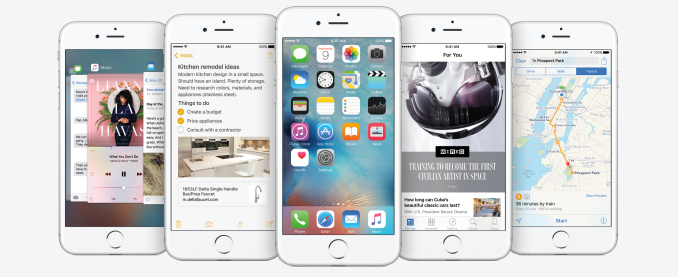The Apple iOS 9 Review
by Brandon Chester on September 16, 2015 8:00 AM EST- Posted in
- Smartphones
- Apple
- Mobile
- Tablets
- iOS 9

2015 has been a pretty big year for Apple as a company. Product launches this year included the Apple Watch, the iPhone 6s and 6s Plus, the iPad Mini 4, the iPad Pro, and the new Apple TV. This month is a big month for their software launches, with today marking the release of iOS 9 as well as watchOS 2, and OS X El Capitan launching at the very end of the month. In time I hope to do some sort of review of the new features in watchOS 2, but today's article focuses strictly on iOS 9 and everything new that Apple is bringing to their biggest operating system for both users and developers.
What's interesting about iOS 9 is how Apple has involved their community of users in the development process by creating a public beta program. OS X Yosemite famously was the first version of OS X to have a public beta (with the exception of the OS X 10.1 Kodiak beta 15 years ago), but Apple had never done anything like it for their mobile devices until now. However, many users found ways to install the developer betas of iOS on their devices by bypassing the activation or having a service register their UDID for beta installation. With more and more features being added to iOS, and more and more users adopting devices that run it, it appears that Apple felt that expanding their beta user base beyond developers would be a good way to collect information on bugs and stability, as well as general feedback about what does and doesn't work well.
Opening up iOS 9 with a public beta also plays into the focus of the new release. iOS 7 was an enormous release that redesigned the entire operating system, and iOS 8 added features like continuity and extensibility to improve how apps communicated on iOS, and how iOS devices and Macs communicate with each other. With all those changes there has been concern that there hasn't been enough attention to polish and eliminating bugs in iOS. While it's not something explicitly stated, it's clear that iOS 9 does go back to basics in some ways, and focuses on improving performance and stability. There are still new features, and some of them are very integral to keeping iOS competitive as a mobile platform, but the key focus is on solidifying the existing foundations.
The polish and improvements that will be most obvious to the end user are those that involve visual or functional changes to the apps they use on a daily basis. With that in mind, it makes most sense to start off the review by taking a look at some of the general changes made to the UI and the system in iOS 9, so let's dive in.











227 Comments
View All Comments
robinthakur - Thursday, October 1, 2015 - link
Yer, even though you've been using a macbook since 2011, perhaps you just don't know how to use it efficiently. I have no issue dealing with large amounts of files in OSX which I have to do as a web developer...melgross - Wednesday, September 16, 2015 - link
A billion dollar business. As if that means anything. Microsoft sold possibly as many as 3.5 million Surface tablets in the past 12 months. Apple sold about 55 million. I doubt Apple is worried about Surface.And as for business, it amazes me how little people seem to know. 75% of all tablets in business and government are iPads. Most of the rest are Android tablets used in less critical applications. A handful of Surface tablets can be found, mostly in IT.
Sc0rp - Wednesday, September 30, 2015 - link
Bingo. You hit the nail on the head!darkich - Thursday, September 17, 2015 - link
LOL.On top of all the ridiculous stuff you managed to say, you of course are still blind to the most obvious fact - surface pro is just a horrible TABLET compared to the iPad.
Sc0rp - Wednesday, September 30, 2015 - link
The surface is a billion dollar a year business while apple makes well over 20 billion a year in iPad sales alone. Not to mention app and media sales from Apple's app and iTunes stores.Apple has sold a quarter billion iPads total since the launch in 2010.
bigstrudel - Saturday, October 3, 2015 - link
Lucky for getting a developing a new core from scratch every year?Apple is absolutely smoking Intel, and is literally years ahead of ARM. To be honest, Apple has been FAR ahead of everyone since the A6 Swift Core in the iPhone 5 completely thrashed Krait, only 6 months after Krait released.
Qualcomm went on to use Krait for 4 years. Apple replaced Swift with a brand new, completely custom 64bit Cyclone cores the very next year.
dargonesti - Monday, March 7, 2016 - link
I wasn't expecting that ammount of tech knowledge here o.oI like you
guidryp - Wednesday, September 16, 2015 - link
The devil is in the details.I have a Samsung Tablet, and the first thing I did was disable split screen after trying it once.
I expect Apple actually made split screen more usable.
I am also pissed that Samsung apparently abandoned OS upgrades on my tablet (Kitkat from day one, never upgraded).
#myLastAndroidTablet
Scabies - Wednesday, September 16, 2015 - link
#AnandtechDoesntDoHashtagsFlunk - Wednesday, September 16, 2015 - link
Your problems are more about Samsung than Android. My Nexus 10 was released in 2012 and is still getting updates (although I think that it's probably getting close to the end).